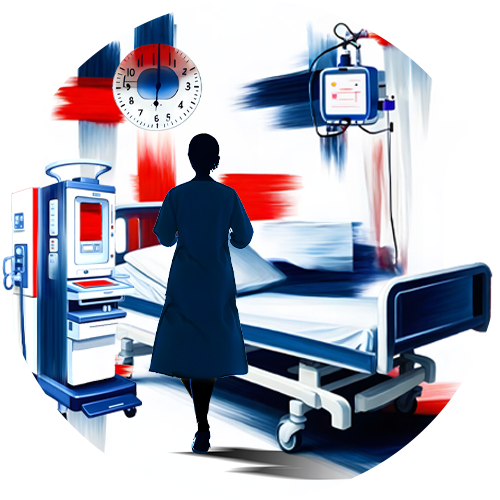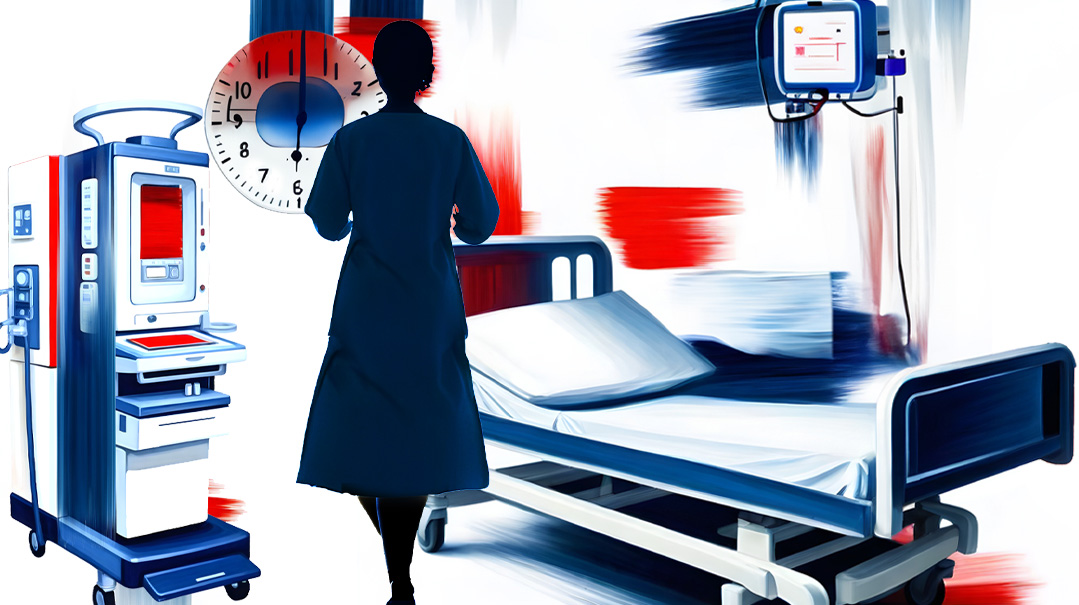On Call: Chapter 7 — Coming Together
| May 21, 2024And it’s on to the next poisoned patient, with the same beautiful synchronization of care

“What does it feel like to save lives?” one of the guests at the Shabbos table wants to know, a hint of admiration in her eyes. I’m asked this question surprisingly often, and I always try to set the record straight.
“I don’t,” I tell her. When she recoils, I explain. “It takes a lot of gaavah to say, ‘I’m saving lives.’ I see too many cases every day not to realize that only Hashem has the power to heal.”
“Well, of course,” she persists. “But when Hashem lets you save someone — you know, like you save a choking victim, or you cure someone who’s having a heart attack — isn’t that a great feeling?”
I keep a straight face as I tell her that the image of the ER doctor sailing in and saving patients (with an ‘S’-marked cape, perhaps?) is not the reality on the ground.
She doesn’t look convinced, and I reflect that the culture of emergency medicine is something that needs to be experienced. Of course, we want to save lives (with Hashem’s help, whether we acknowledge it or not!), but the key is “we.”
This is evident during my two-month stint in the ICU department of a prestigious Chicago hospital. (First-year residents in our program rotate through different medical departments in different hospitals, learning a broad range of skills and seeing varied approaches to medical issues.)
Rumors are spreading among the staff members — new patients are coming. Because we need to prep rooms and get ready, ICU staff are always checking to see if any newcomers are scheduled to arrive. This time, gossip gets there first — especially when two ICU residents are called down to the ER to help evaluate two patients.
“It’s a carbon monoxide poisoning case,” one of the nurses says.
“I was just down there,” a resident tells everyone. “I’m not sure what happened to the kids, but it’s serious. Anesthesiology intubated them, and we did some bloodwork. They’re using the hyperbaric chamber now. First patient should be coming up in about half an hour. Then they’ll put the second patient in the chamber and send him up later.”
Carbon monoxide poisoning. This is the first time I’ve ever seen a case, even though I know there are about 50,000 of them per year in the United States. Carbon monoxide binds to the hemoglobin on red blood cells, which stops the cells from taking in oxygen. In large amounts, carbon monoxide poisoning is a swift death, as all the organs in the body shut down — and it’s difficult to remove the gas from the body. The hyperbaric chamber, where patients breathe 100 percent pure oxygen at higher-than-normal pressure, will hopefully increase oxygen levels.
When the official call comes from the ER, the attending assembles the team and we start to get ready for a three- or four-hour marathon.
“Did you eat lunch?” the attending asks me, concerned. “It’s going to be a long session.” When I nod, he adds, “And your after-meal prayers? Did you say those yet?” I nod again, amused at the religious education I’m providing my fellow doctors.
The ICU room where we prepare for the first patient is brimming with calm, focused energy. The two attending doctors stand nearby as three nurses, together with a respiratory therapist, wheel the patient into the room. One nurse hooks the patient to a cardiac monitor and takes his blood pressure, while another nurse puts another IV into the teen’s arm, and the third nurse checks the IV, straightening the bags of fluid. The respiratory therapist adjusts the intubation tube and manages the oxygen, making sure that the lifesaving airway is clear of any obstruction.
It’s a swift, efficient choreography around the unconscious, heavily sedated boy.
“The blood pressure is too low,” one of the attendings says sharply, looking at the numbers on the blood pressure cuff.
“How about a bedside echocardiogram, so we can see what’s going on internally?” the second attending suggests. He grabs the ultrasound machine and places the ultrasound probe on the patient. His suspicion is confirmed. The heart isn’t working properly, slowly starving the organs of life-giving blood.
“It’s cardiogenic shock. Not a good squeeze in the heart. Let’s start him on epinephrine,” I say. Epinephrine will work the patient’s heart harder and faster, constricting blood vessels and raising the pressure. “We need to place a central line so we can safely medicate to support the blood pressure.” It’s time to move quickly — the body in front of us seems to be growing limper and paler as we speak.
The attending doctors agree, and I find myself with the ultrasound machine, poised over my patient’s neck. After cleaning the site carefully, the sterile gel is squeezed onto the skin. I’m holding the central line IV in one hand, maneuvering the ultrasound probe with the other. The first time I did this was terrifying, but now, as the end of my first year in residency approaches, it feels reassuringly familiar.
On the ultrasound screen, I see the internal jugular. Slowly inserting the needle into the vein, I thread the wire into the vena cava, a major vein of the heart. After dilating the thin wire, I place the central venous catheter into the vein. It’s one of the safest ways to pump strong medication into our patients, and a nurse quickly sets up an epinephrine drip connected to my IV.
“I’m going to insert an arterial line so we can keep a constant eye on the blood pressure,” the first attending says. As he puts another IV line into the boy’s wrist, we watch the numbers on the monitors.
“Let’s start some milrinone to augment the blood pressure,” raps out the other attending, and the order is sent to the pharmacy. Ten minutes later the arterial line is placed, the patient is receiving both medications, and we can already see the blood pressure stabilizing. When the patient shows no alarming changes, we leave one of the ICU nurses to sit near the unconscious boy, monitoring every glowing line and number.
And it’s on to the next poisoned patient, with the same beautiful synchronization of care. I love this symphony, the harmonious way each of us completes our jobs, the seamless melding of advice, orders, and efficiency. It’s a siren song of hope and healing, of disparate parts coming together, of prayer in motion, and it never loses its power to enchant.
What does it feel like?
The most rewarding job in the world.
The characters in this series are composites; all the stories are true.
(Originally featured in Family First, Issue 894)
Oops! We could not locate your form.


